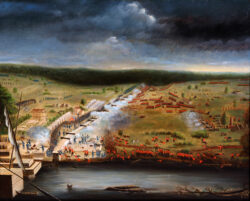Jean-Hyacinthe Laclotte
Jean-Hyacinthe Laclotte is best remembered for his painting of the 1815 Battle of New Orleans.

Courtesy of New Orleans Museum of Art
Battle of New Orleans. Laclotte, Jean Hyacinthe de (Artist)
Jean-Hyacinthe Laclotte was an architect and artist active in New Orleans from 1804 to 1817. He painted an image of the Battle of New Orleans that is considered to be the most accurate depiction of the 1815 clash between British troops and American fighters under the command of General Andrew Jackson. He was also an art professor who taught architecture, drawing, and painting, and he was a set designer for early French theater in New Orleans.
Born in 1766 in Bordeaux, France, Laclotte, a third-generation architect, arrived in New Orleans in 1804. Very little is known about his education except that he attended the École des Beaux-Arts in Paris. Some of his early work included designs for a room in the New Orleans Customhouse in 1805 and a turret containing a circular staircase that was intended for but not built in The Cabildo in 1807. In 1806 he created a design for the Orleans Theatre that was finally built in 1814 but was destroyed by fire shortly afterward, and he drew the plan for a house on Levee and Poydras Streets in 1807. An 1806 New Year’s Eve fireworks display also brought him public attention. In 1807 Laclotte opened a school for architecture and drawing. He may have lived in Mexico between 1807 and 1810.
In 1810 Laclotte opened an art school and architectural firm in New Orleans with fellow architect Arsène Lacarriere Latour. They taught architectural design, painting, and drawing, and their curriculum was based on that of the École des Beaux-Arts. In 1811 Laclotte and Latour designed the Monnier House on the corner of Royal and St. Peter Streets. Colloquially known in the French Quarter as the “skyscraper,” the building has four stories, curved corner walls, and balconies overlooking the streets; the interior boasts an oval salon. In 1813 Laclotte likely also designed a country house for the Macarty family and the Delord-Sarpy House, and planned the Faubourg Plaisance subdivision. Between 1810 and 1813 he designed sets for the Orleans and St. Philippe Theatres, which presented French opera and drama. In 1813 Laclotte and Latour’s firm dissolved in bankruptcy.
In 1815, as the Battle of New Orleans loomed, Laclotte volunteered as an engineer in the First Louisiana Militia. At the front, he sketched the battle as it raged; he then returned to his studio to paint directly from his sketches. Laclotte left the original painting in Philadelphia, Pennsylvania, and traveled to France with a copy to be engraved, but it was lost. As a result, publication of the engraving by Philibert-Louis Debucourt was delayed but was ready for sale by 1817. The print was entitled Defeat of the British Army, 12,000 strong under the Command of Sir Edward Packenham, in the attack of the American lines defended by 3,600 Militia commanded by Major General Andrew Jackson January 8the 1815, on Chalmette plain, five miles below New Orleans on the left bank of the Mississippi. Drawn on the Field of Battle and painted by Hthe Laclotte archt. and assist Engineer in the Louisiana Army the Year 1815. On the print, the words “Defeat” and “Packenham” are emphasized: their letters are the largest and are situated on the top printed line, a display that suggests Laclotte’s delight at the defeat of the British. Laclotte went to Philadelphia to sell the prints and returned to Bordeaux, where he lived for the rest of his life, dying in 1828 or 1829.
